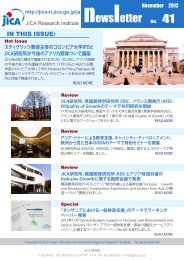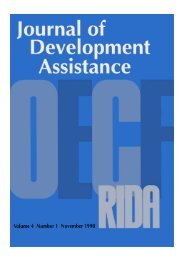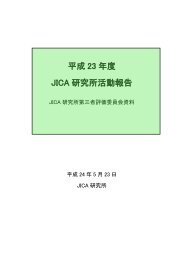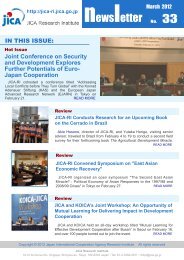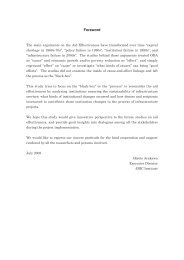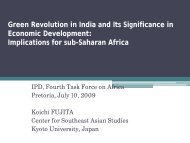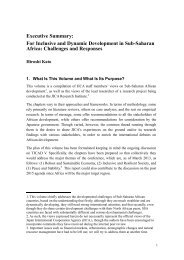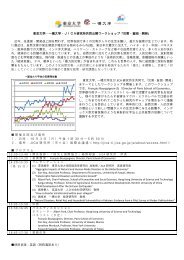Chapter 1 The Social and Political Environment in Tanzania ...
Chapter 1 The Social and Political Environment in Tanzania ...
Chapter 1 The Social and Political Environment in Tanzania ...
Create successful ePaper yourself
Turn your PDF publications into a flip-book with our unique Google optimized e-Paper software.
<strong>Chapter</strong> 1 <strong>The</strong> <strong>Social</strong> <strong>and</strong> <strong>Political</strong> <strong>Environment</strong> <strong>in</strong> <strong>Tanzania</strong>: Background to the Project<br />
<strong>Chapter</strong> 1 <strong>The</strong> <strong>Social</strong> <strong>and</strong> <strong>Political</strong> <strong>Environment</strong> <strong>in</strong> <strong>Tanzania</strong>:<br />
Background to the Project<br />
This case study will take up <strong>and</strong> illustrate a general overview of the Morogoro Health Project (MHP).<br />
Before proceed<strong>in</strong>g with this, however, it will beg<strong>in</strong> with a synopsis of what sort of social <strong>and</strong> economic<br />
situation <strong>Tanzania</strong> was <strong>in</strong> as the historical backdrop to when the project was requested <strong>and</strong> formulated. It<br />
will also outl<strong>in</strong>e the manner <strong>in</strong> which the HSR, decentralization, <strong>and</strong> other national development strategies<br />
were worked out.<br />
1-1 <strong>Social</strong> <strong>and</strong> Economic Situation<br />
In May 1992 <strong>Tanzania</strong> transitioned from s<strong>in</strong>gle-party rule under the Revolutionary Party to a multiparty<br />
system, <strong>and</strong> <strong>in</strong> October 1995 elections for the president <strong>and</strong> members of parliament were conducted<br />
for the first time under this multi-party system. <strong>Tanzania</strong> is said to be one of the most politically stable<br />
countries among the countries of Africa. S<strong>in</strong>ce the <strong>in</strong>troduction of the multi-party system, the political <strong>and</strong><br />
social situation has rema<strong>in</strong>ed stable under the leadership of the govern<strong>in</strong>g CCM (Chama Cha Map<strong>in</strong>duzi,<br />
Revolutionary Party). In 2000, President Benjam<strong>in</strong> William Mpaka was reelected, <strong>and</strong> <strong>in</strong> 2005 the former<br />
M<strong>in</strong>ister of Foreign Affairs <strong>and</strong> International Cooperation Jakaya Mrisho Kikwete was <strong>in</strong>augurated as the<br />
new president, with both of them represent<strong>in</strong>g CCM.<br />
Diplomatically, s<strong>in</strong>ce 2001 <strong>Tanzania</strong> along with Kenya <strong>and</strong> Ug<strong>and</strong>a have comprised the East African<br />
Community (EAC). In striv<strong>in</strong>g to strengthen regional cooperation, it has entered an EAC customs union<br />
that came <strong>in</strong>to effect beg<strong>in</strong>n<strong>in</strong>g <strong>in</strong> January 2005. Furthermore, it served as the chair country for the<br />
Southern African Development Community (SADC) for one year start<strong>in</strong>g <strong>in</strong> August 2003. As an important<br />
member, <strong>Tanzania</strong> has played the important role of a mediator <strong>in</strong> Eastern <strong>and</strong> Southern Africa. Moreover, it<br />
also displays diplomatic leadership aimed at achiev<strong>in</strong>g peace <strong>in</strong> Burundi <strong>and</strong> the Democratic Republic of<br />
the Congo <strong>in</strong> order to stabilize the Great Lakes region as a whole.<br />
In addition, s<strong>in</strong>ce 1995 <strong>Tanzania</strong>’s economic situation has been show<strong>in</strong>g favorable growth as a result of<br />
the implementation of the development strategies described above. Over the five year period from 2000 to<br />
2004 the country has displayed a real economic growth rate that is at the high level of 5.8%. This growth<br />
has largely come about as a result of the development of the m<strong>in</strong><strong>in</strong>g <strong>in</strong>dustry, which is centered around gold<br />
(over this period the m<strong>in</strong><strong>in</strong>g <strong>in</strong>dustry had an average yearly growth rate of 15.2%). <strong>The</strong> average yearly<br />
growth rate over this same period for the agricultural sector, which constitutes 80% of <strong>Tanzania</strong>’s labor<br />
population, rema<strong>in</strong>ed at 4.8%. For this reason, the stable development of rural areas, which comprise<br />
roughly 80% of the total population <strong>and</strong> some 80 to 90% of those liv<strong>in</strong>g <strong>in</strong> poverty, will be a challenge for<br />
the immediate future. It is important that poverty reduction be achieved <strong>in</strong> a visible manner that does not<br />
unevenly distribute the benefits of growth solely to urban areas.<br />
1-2 Poverty Reduction Strategies<br />
In 1997 the <strong>Tanzania</strong>n Government formulated the National Poverty Eradication Strategy (NPES) as a<br />
national development strategy. <strong>The</strong>n, <strong>in</strong> 1999 it announced Vision 2025, which stipulated the course for<br />
long-term development <strong>in</strong> <strong>Tanzania</strong> (improv<strong>in</strong>g the quality of life, ensur<strong>in</strong>g good governance <strong>and</strong> the rule of<br />
law, <strong>and</strong> a competitive economy). Tak<strong>in</strong>g these as its basic policies, <strong>in</strong> 2000 it was the first among other<br />
1
Project for Strengthen<strong>in</strong>g District Health Services <strong>in</strong> the Morogoro Region, <strong>Tanzania</strong><br />
countries to formulate a Poverty Reduction <strong>and</strong> Strategy Paper (PRSP), <strong>in</strong>itiat<strong>in</strong>g Poverty Reduction Budget<br />
Support (PRBS) the next year <strong>in</strong> 2001. 1 Follow<strong>in</strong>g this, it created the <strong>Tanzania</strong> Assistance Strategy (TAS) <strong>in</strong><br />
2002, <strong>and</strong> the National Strategy for Growth <strong>and</strong> the Reduction of Poverty (NSGRP; or MKUKUTA <strong>in</strong><br />
Swahili) <strong>in</strong> 2005 to serve as its second poverty reduction strategy. 2 In parallel with the sett<strong>in</strong>g <strong>in</strong> place of<br />
such policy foundations, it also established f<strong>in</strong>ancial foundations such as the Public Expenditure Review<br />
<strong>and</strong> the Medium-Term Expenditure Framework (MTEF), <strong>and</strong> developed laws one after another. This was<br />
done for the implementation of the national development plans PRSP/NSGRP.<br />
<strong>The</strong> First PRSP (2000) aimed to directly benefit specified impoverished groups via priority sectors<br />
such as health <strong>and</strong> medic<strong>in</strong>e, education, <strong>and</strong> others. While hold<strong>in</strong>g to a policy of reduc<strong>in</strong>g poverty, the<br />
second poverty reduction strategy from April 2005 narrowed its focus down to “poverty reduction through<br />
growth <strong>and</strong> <strong>in</strong>come,” “improv<strong>in</strong>g the quality of life <strong>and</strong> social welfare,” <strong>and</strong> “good governance <strong>and</strong><br />
accountability.” <strong>The</strong> health sector was <strong>in</strong>tegrated <strong>in</strong>to the social welfare service cluster along with<br />
education, water, <strong>and</strong> the environment. Enhanc<strong>in</strong>g the policy foundation posed a challenge for the sake of<br />
enabl<strong>in</strong>g cross-sectoral activities <strong>and</strong> f<strong>in</strong>ancial cooperation.<br />
1-3 Sector-Wide Approach (SWAp)<br />
<strong>The</strong> 1995 Helle<strong>in</strong>er Report criticized the proliferation of <strong>in</strong>dividual projects as impos<strong>in</strong>g a significant<br />
burden on the part of the partner country, <strong>and</strong> po<strong>in</strong>ted out that aid should be provided <strong>in</strong> a manner that is<br />
consistent with the policies of the partner country. In particular, the report clearly <strong>in</strong>dicated that donor-led<br />
development aid acts as a h<strong>in</strong>drance to foster<strong>in</strong>g ownership by the partner country. This is exemplified by<br />
the <strong>in</strong>efficiency of project implementation by <strong>in</strong>dividual aid agencies, as well as government employees <strong>in</strong><br />
the partner countries los<strong>in</strong>g out on opportunities to carry out their basic duties as a result of their hav<strong>in</strong>g to<br />
deal with differ<strong>in</strong>g aid modalities. As a result, aid coord<strong>in</strong>ation designed to foster <strong>Tanzania</strong>’s self-reliance<br />
was exam<strong>in</strong>ed, <strong>and</strong> <strong>in</strong> 1998 a health SWAp was <strong>in</strong>troduced ahead of the other sectors. Because of this, use<br />
of the HSBF was begun <strong>in</strong> 1999 as an <strong>in</strong>dependent revenue source for decentralized health systems.<br />
Figure 1-1 illustrates by what sort of stages aid coord<strong>in</strong>ation was carried out <strong>in</strong> the project account<strong>in</strong>g<br />
<strong>and</strong> government general account<strong>in</strong>g systems. <strong>The</strong> “ownership of the partner country <strong>and</strong> the establishment<br />
of susta<strong>in</strong>ability” are emphasized <strong>in</strong> the SWAp. It def<strong>in</strong>es the objective as be<strong>in</strong>g to carry out budget<br />
draft<strong>in</strong>g, execution, <strong>and</strong> evaluation <strong>and</strong> monitor<strong>in</strong>g under the unified control of the partner country.<br />
Sugishita (2006) lists the follow<strong>in</strong>g items as outcomes of the <strong>in</strong>troduction of a health SWAp <strong>in</strong> <strong>Tanzania</strong>.<br />
- A foundation was established by which the government <strong>and</strong> development partner were able to work<br />
together to implement development strategies <strong>in</strong> l<strong>in</strong>e with the nation’s priority issues.<br />
- <strong>The</strong> strategic aspects were clarified by means of shar<strong>in</strong>g the monitor<strong>in</strong>g system for the achievement<br />
of national objectives.<br />
- Set the foundation for the susta<strong>in</strong>able <strong>and</strong> autonomous development of district health provision<br />
founded on a long-term outlook by means of stably ensur<strong>in</strong>g revenue sources for health <strong>in</strong> local areas.<br />
- Allowed comprehensive sector-spann<strong>in</strong>g regional development to be conducted by means of<br />
strengthen<strong>in</strong>g collaboration between government functions <strong>and</strong> local government authorities.<br />
- Can be expected to <strong>in</strong>crease the efficiency <strong>and</strong> transparency of aid, as well as utilize resources<br />
1 Japan has contributed an amount of 500 million yen to PRBS through grant aid for debt relief on two occasions, once <strong>in</strong><br />
March 2002 <strong>and</strong> aga<strong>in</strong> <strong>in</strong> March 2003. In 2004 Japan approved the <strong>in</strong>put of substantial fund<strong>in</strong>g of non-project grant aid.<br />
2 MKUKUTA is the abbreviation for Mkakati wa Kukuza Uchumi na Kupunguza Umask<strong>in</strong>i <strong>Tanzania</strong>.<br />
2
Project for Strengthen<strong>in</strong>g District Health Services <strong>in</strong> the Morogoro Region, <strong>Tanzania</strong><br />
be <strong>in</strong>troduced.<br />
iii) It is essential that the Regional Health Management Team (RHMT) provides the Council Health<br />
Management Teams (CHMTs) with technical <strong>and</strong> managerial support on a case by case basis<br />
accord<strong>in</strong>g to needs. 3<br />
iv) Motivated <strong>and</strong> eager human resources should be allocated.<br />
v) Pert<strong>in</strong>ent <strong>and</strong> well-managed health <strong>in</strong>frastructure is required.<br />
vi) A sufficient budget should be guaranteed.<br />
vii) CHMTs must encourage the participation of residents <strong>and</strong> the medical care providers at health<br />
facilities, as well as act with accountability.<br />
viii) Tools to evaluate the quality of health services <strong>and</strong> st<strong>and</strong>ard operat<strong>in</strong>g procedures should be adopted.<br />
Year<br />
1991<br />
1993<br />
1994<br />
1995<br />
1997<br />
1998<br />
1999<br />
2000<br />
2001<br />
2002<br />
2003<br />
2004<br />
2005<br />
2006 Jo<strong>in</strong>t Assistance Strategy<br />
Source: Compiled from Cowi et al. (2007)<br />
Table 1-1 Health Sector Reform <strong>and</strong> its Surround<strong>in</strong>g Policies<br />
Development Policy Health Policy<br />
Public Sector Reform Programs<br />
Civil Service Reform<br />
Vision 2025<br />
National Poverty Eradication Strategy<br />
<strong>Tanzania</strong> Assistance Strategy(draft)<br />
Poverty Reduction Strategy Paper<br />
(medium-term development plan)<br />
(Millennium Development Goals)<br />
Poverty Reduction Budget Support<br />
Public Expenditure Review 4<br />
MTEF 2002-2004<br />
<strong>Tanzania</strong> Assistance Strategy<br />
Poverty Reduction Strategy Paper II<br />
(medium-term development plan)<br />
MTEF 2004- 2007<br />
National Strategy for Growth <strong>and</strong> Reduction of<br />
Poverty= MKUKUTA (2005-2010)<br />
Jo<strong>in</strong>t Assistance Strategy (draft)<br />
4<br />
Health Sector Reform Policy <strong>and</strong> Guidel<strong>in</strong>es<br />
Health Sector Reform Proposal 1996- 2000<br />
(proposed the <strong>in</strong>troduction of a SWAp)<br />
Proposal for a Sector-wide Improvement Program<br />
(SIP)<br />
Agreement on Health SWAp<br />
Health Sector Strategic Plan 1999-2002<br />
Health Sector Basket Fund<br />
Introduction of Comprehensive Council Health Plan<br />
National Package of Essential Health Interventions<br />
Community Health Fund<br />
<strong>Tanzania</strong> Commission for AIDS (TACAIDS)<br />
National Health Policy(revised version)<br />
National Health Insurance Fund (NHIF)<br />
Global Fund for AIDS, TB <strong>and</strong> Malaria (GFATM)<br />
Health Sector Strategic Plan II 2003-2008<br />
Emergency Infrastructure Rehabilitation Program<br />
<strong>Tanzania</strong> HIV Indicator Survey (THIS)<br />
TEHIP tools rollout (half of the districts)<br />
Guidel<strong>in</strong>es for the Reform of Regional <strong>and</strong> District<br />
Hospitals<br />
3 CHMTs <strong>and</strong> RHMT are comprised of regional <strong>and</strong> district physicians <strong>and</strong> health officers, as well as staff members from<br />
regional <strong>and</strong> district hospitals <strong>and</strong> others. In districts they effectively serve as the health divisions for the government<br />
authorities, <strong>and</strong> at the regional level they play a role of technically support<strong>in</strong>g the region as branch agencies of the<br />
MOHSW.<br />
4 Public Expenditure Review by the <strong>Tanzania</strong>n Government through donor participation.
Project for Strengthen<strong>in</strong>g District Health Services <strong>in</strong> the Morogoro Region, <strong>Tanzania</strong><br />
1-5 Local Government Reform Programme (LGRP)<br />
1-5-1 Transformation of Local Adm<strong>in</strong>istrative Policies<br />
In 1972 the <strong>Tanzania</strong>n Government did away with the local government authorities that had persisted<br />
until that time. <strong>The</strong> reasons for this <strong>in</strong>cluded a shortage of capable adm<strong>in</strong>istrators, improper disbursements<br />
from budgets, a lack of operation <strong>and</strong> ma<strong>in</strong>tenance capacity for the social <strong>in</strong>frastructure developed by the<br />
central government, a lack of managerial capacity on the part of adm<strong>in</strong>istrators, <strong>and</strong> others. After that, from<br />
1972 to 1984 the system shifted to one of centralized adm<strong>in</strong>istrative authority, thereby turn<strong>in</strong>g <strong>in</strong>to a<br />
bureaucratic, <strong>in</strong>efficient, <strong>and</strong> <strong>in</strong>effectual system. <strong>The</strong> decl<strong>in</strong><strong>in</strong>g liv<strong>in</strong>g st<strong>and</strong>ards of the people <strong>and</strong> soar<strong>in</strong>g<br />
costs of operation <strong>and</strong> ma<strong>in</strong>tenance led to a deterioration <strong>in</strong> social <strong>and</strong> economic services. It was<br />
acknowledged that the morbidity <strong>and</strong> disease prevalence rates were <strong>in</strong>creas<strong>in</strong>g as a result of the drop <strong>in</strong> the<br />
number of people receiv<strong>in</strong>g health services, while literacy rates were decl<strong>in</strong><strong>in</strong>g along with the decrease <strong>in</strong><br />
the number of children enrolled <strong>in</strong> primary education. In 1984 the central government set out to rebuild the<br />
local government authorities <strong>in</strong> the wake of legal reforms, <strong>and</strong> the provision of adm<strong>in</strong>istrative services by<br />
local government authorities was resumed. However, the number of public servants had decreased<br />
substantially on account of the structural adjustment programs implemented from the 1980s to the 1990s.<br />
As such, there was a shortage of human resources, <strong>and</strong> all of a sudden improv<strong>in</strong>g the quality of regional<br />
public services was no longer feasible.<br />
Decentralization by devolution (D by D) was articulated <strong>in</strong> the 1998 Policy Paper on Local<br />
Government Reform. <strong>The</strong> objectives for this were given as devolv<strong>in</strong>g authority related to personnel,<br />
f<strong>in</strong>ances, <strong>and</strong> other matters to the local government authorities, as well as rebuild<strong>in</strong>g the adm<strong>in</strong>istrative<br />
system (Table 1-1). Follow<strong>in</strong>g this, the LGRP was officially announced <strong>in</strong> 2000. This ranked the health,<br />
education, water, agriculture, <strong>and</strong> roads sectors together as strategic pillars for restructur<strong>in</strong>g of regional<br />
adm<strong>in</strong>istration <strong>and</strong> poverty reduction. <strong>The</strong> follow<strong>in</strong>g objectives are established with<strong>in</strong> the LGRP.<br />
- A system of local government authorities with autonomous authority 5<br />
- A system of local government authorities with resources (particularly f<strong>in</strong>ancial <strong>and</strong> human resources)<br />
- Local authorities comprised of democratically elected leaders<br />
- Local authorities that allow for public participation <strong>in</strong> development plann<strong>in</strong>g <strong>and</strong> implementation<br />
- A system which reflects regional needs<br />
- An autonomous system which ensures transparency <strong>and</strong> accountability<br />
Furthermore, the follow<strong>in</strong>g matters were requested of the various local government authorities with<br />
regard to the devolution of authority to the local areas. 6<br />
- Establish comprehensive strategies <strong>and</strong> objectives aimed at improv<strong>in</strong>g public services<br />
- Establish <strong>in</strong>dicators to measure performance<br />
- Identify causes for discrepancies <strong>in</strong> performance<br />
- Invest strategic resources (f<strong>in</strong>ancial, human resources) so that services benefit the local residents<br />
- Promote democracy <strong>in</strong> the determ<strong>in</strong>ation process<br />
<strong>The</strong> follow<strong>in</strong>g action policies are <strong>in</strong>dicated <strong>in</strong> the Mid-term Plan <strong>and</strong> Budget 2005-2008 (MTP05-08),<br />
which serves as a specific action plan for the achievement of the items above.<br />
5 Additionally, at the regional level <strong>in</strong> <strong>Tanzania</strong> regional governments which act as branch agencies of the central<br />
government have been established <strong>in</strong>stead of local government authorities.<br />
6 PMO-RALG (2004) p. 5<br />
6
<strong>Chapter</strong> 1 <strong>The</strong> <strong>Social</strong> <strong>and</strong> <strong>Political</strong> <strong>Environment</strong> <strong>in</strong> <strong>Tanzania</strong>: Background to the Project<br />
- Ma<strong>in</strong>stream<strong>in</strong>g of D by D<br />
- Fiscal Empowerment<br />
- Human Resource Empowerment<br />
- Legal Framework<br />
- Restructur<strong>in</strong>g LGAs<br />
- Governance<br />
- PMO-RALG & Regional State Capacity Build<strong>in</strong>g<br />
Based on the aforementioned items, the provision of various public services was transferred from the<br />
central government to the local government authorities. <strong>The</strong>re were problems <strong>in</strong>volved with this, such as<br />
missteps between government m<strong>in</strong>istries <strong>and</strong> agencies, as well as the fact that smooth progress was not seen<br />
with the legal framework or the transfer of personnel authority. Yet regardless, the f<strong>in</strong>ancial foundations<br />
were established with<strong>in</strong> the m<strong>in</strong>istries for local authorities <strong>in</strong> a manner consistent with the national<br />
development plans (PRSP, TAS, MKUKUTA, etc.). <strong>The</strong> basket fund designed to promote the LGRP serves<br />
as an example of this.<br />
1-5-2 Decentralization of Health Services through the LGRP<br />
<strong>The</strong> <strong>in</strong>troduction of the LGRP <strong>in</strong> 2000 def<strong>in</strong>ed the roles of the central <strong>and</strong> local governments: the<br />
former formulates policies <strong>and</strong> the latter provides adm<strong>in</strong>istrative services, <strong>in</strong>clud<strong>in</strong>g the plann<strong>in</strong>g,<br />
implementation, <strong>and</strong> monitor<strong>in</strong>g of various projects <strong>and</strong> programs. With<strong>in</strong> the health sector, the carry<strong>in</strong>g out<br />
of health <strong>and</strong> medical services was transferred to the <strong>in</strong>itiative of the local government authorities. Due to<br />
the devolution of authority with regard to personnel, health sector human resources were shifted from the<br />
MOHSW to the local government authorities. Furthermore, <strong>in</strong> the wake of the decentralization the division<br />
of labor among central government m<strong>in</strong>istries <strong>and</strong> agencies changed as well. Local governments were<br />
required to manage local revenue sources <strong>and</strong> provide services, while the MOHSW was called upon to<br />
strengthen its capacity for technical backstopp<strong>in</strong>g <strong>and</strong> human resources development.<br />
Figure 1-3 offers a comparison of the relationship diagrams from 2001 <strong>and</strong> 2005 for actors who had<br />
their roles altered as a consequence of the decentralization. Prior to decentralization, MOHSW ma<strong>in</strong>ta<strong>in</strong>ed<br />
consistent responsibility for everyth<strong>in</strong>g from policy formulation to the implementation of services, <strong>and</strong><br />
CHMTs provided services as branch agencies of the MOHSW. After decentralization, the fact has not<br />
changed that MOHSW still formulates the policy. However, services <strong>in</strong> the local areas are provided solely<br />
by the districts, <strong>and</strong> the President’s Office-Regional Adm<strong>in</strong>istration <strong>and</strong> Local Government (PO-RALG,<br />
currently the Prime M<strong>in</strong>ister’s Office-Regional Adm<strong>in</strong>istration <strong>and</strong> Local Government (PMO-RALG))<br />
came to bear responsibility for the supervision <strong>and</strong> backstopp<strong>in</strong>g of adm<strong>in</strong>istrative management as a whole.<br />
<strong>The</strong> function of the MOHSW has changed to focus on the formulation of the policies as well as technical<br />
backstopp<strong>in</strong>g <strong>and</strong> support to the local authorities.<br />
Budgetary allocations from the HSBF to the RHMT, which are part of the central government, were<br />
not planned <strong>in</strong> the <strong>in</strong>stitutional design from the time of the HSBF’s establishment. But gradually, however,<br />
autonomous activities like the backstopp<strong>in</strong>g <strong>and</strong> supervisory functions of regional governments target<strong>in</strong>g<br />
district governments came to be called for. Based on this background, <strong>in</strong> 2005 it became possible for the<br />
HSBF to make contributions to the RHMT. 7<br />
7 Dur<strong>in</strong>g the implementation of MHP, expenses were not actually allocated to the RHMTs for their rout<strong>in</strong>e visits <strong>and</strong><br />
guidance to the various districts.<br />
7
<strong>Chapter</strong> 1 <strong>The</strong> <strong>Social</strong> <strong>and</strong> <strong>Political</strong> <strong>Environment</strong> <strong>in</strong> <strong>Tanzania</strong>: Background to the Project<br />
Box 1-1 “<strong>The</strong>re’s no budget...” What would you do? (Part 1)<br />
One day I received the message, “<strong>The</strong>re’s no budget, so we can’t attend the next work<strong>in</strong>g<br />
group” on my cell phone. <strong>The</strong> message was sent by a member of the Monitor<strong>in</strong>g <strong>and</strong> Evaluation<br />
(M&E) Work<strong>in</strong>g Group (WG) which I was <strong>in</strong> charge of.<br />
This was <strong>in</strong> the last year of the project. In consideration of autonomous development after its<br />
completion, the project requested that each district bear part of the daily subsistence allowance<br />
(cost shar<strong>in</strong>g) related to the project. This came right <strong>in</strong> the middle of the M&E WG’s compilation<br />
of the “District Health Management H<strong>and</strong>books,” which served as a f<strong>in</strong>al tangible outcome of the<br />
project, <strong>and</strong> <strong>in</strong> which all of the group members played their part for the writ<strong>in</strong>g.<br />
<strong>The</strong> WGs gathered representatives from each district <strong>and</strong> were held over a two to three day schedule on the basis of<br />
at least one each month. <strong>The</strong>refore, we only had a few chances left to come together <strong>in</strong> order to complete the h<strong>and</strong>books as<br />
planned by the end of the project. With each opportunity precious, the situation was such that the participation of each<br />
member shar<strong>in</strong>g the work of writ<strong>in</strong>g for the sake of complet<strong>in</strong>g the tangible outcomes was <strong>in</strong>dispensable.<br />
“When consider<strong>in</strong>g the completion of these tangible outcomes, even though the project was cover<strong>in</strong>g the daily<br />
subsistence allowances, I still preferred that every member took part. This was my true feel<strong>in</strong>g as the manager. At the<br />
same time, “if there was a problem with the bear<strong>in</strong>g of cost between the district <strong>and</strong> CHMTs I would like them to consult<br />
with me openly as the manager.” This was my true feel<strong>in</strong>g, too.<br />
When manag<strong>in</strong>g a project, these sorts of problems concern<strong>in</strong>g daily subsistence allowances <strong>and</strong> lodg<strong>in</strong>g expenses<br />
occur on a daily basis. As such, I realized that the accumulation of these sorts of daily-occurr<strong>in</strong>g matters serves as a<br />
collection of live “lessons” on the ground <strong>in</strong> CD support projects that aim to “improve management capacity.”<br />
So, if you were asked for your judgment as an expert placed <strong>in</strong> such a situation how would you respond?<br />
Furthermore, by what means would you expect the counterpart to deal with this?<br />
9<br />
(Written by: Erika Fukushi, former MHP expert)<br />
(Cont<strong>in</strong>ued <strong>in</strong> Part 2)


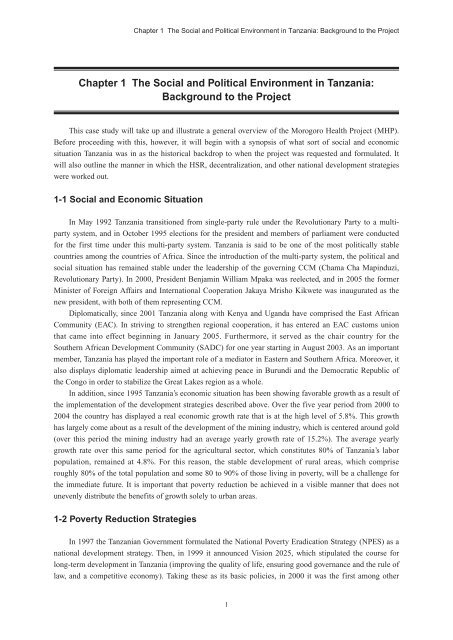
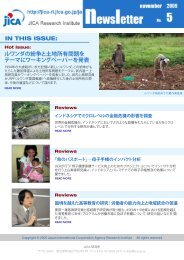


![新たな時代の開発 [寄稿]我が国製造業の競争パフォーマンス 欧州に ...](https://img.yumpu.com/45564809/1/185x260/-.jpg?quality=85)
